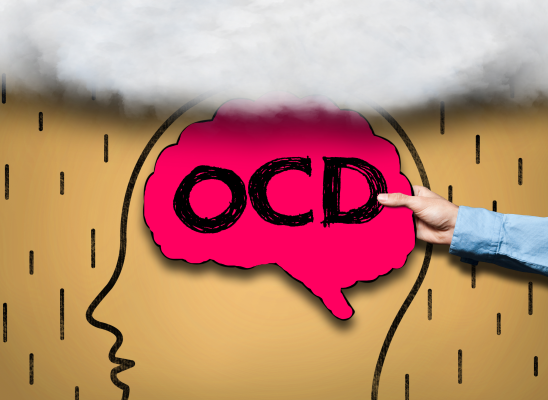
Online test
Find out the severity of your symptoms with this free online test
Obsessive-Compulsive Disorder (OCD) is a mental health condition characterized by persistent, unwanted and intrusive thoughts, images, or urges (obsessions) and repetitive behaviors or mental acts (compulsions) performed to reduce the distress caused by the obsessions. When you think of compulsions, ritual behaviors like handwashing and checking probably come to mind. These compulsions are easily observed and widely recognized as being related to OCD. However, there’s another type of compulsion that you may not be as familiar with and is not as easily recognizable. Mental rituals are often overlooked but can be just as debilitating and disruptive to a person’s life.
What Are Mental Rituals?
Viewed through a psychological lens, a ritual is a rigid, stereotyped action that is performed over and over, based on rules that do not have a rational basis (e.g., having to perform a task in a certain way). These rituals are often used to avoid or alleviate distress. They can be physical or mental actions.
In the context of OCD, mental rituals are compulsive mental processes that individuals perform in response to their obsessions. Unlike physical compulsions, which involve observable actions, mental rituals occur entirely in the person’s mind. Put simply, mental rituals involve doing something in your head to prevent an unwanted outcome or reduce the distress that the obsession creates. While these rituals temporarily reduce the distress, they do not remove the obsession. When the obsession returns, the person again engages in the ritual, creating a vicious cycle of distress and reinforcing the disorder.
When thinking about mental rituals, it’s important to make a distinction between having or noticing a thought, and getting “stuck” or ruminating on that thought (mental rituals). We have thousands of thoughts every day about many different things. Most of the time, we don’t even notice this constant stream of thoughts in our heads. But if we do, we simply think, “oh, ok” and move on.
A mental ritual is different from that. Engaging in mental rituals is like trying to “solve” or “fix” the thought. A person suffering from OCD might have an intrusive thought about stabbing their partner with a knife. Instead of saying “Well, that was an odd thought.” and moving on they might attribute meaning to the thought and attend to or try to control this benign thought. This is where the mental ritual starts. The “trying to do something” might be:
- Trying to push the thought away and not think it
- Ruminating about why the thought came up
- Thinking about how this thought might be connected to one’s intentions or personality
- Trying to think of all the reasons why one would never do this
- Actively trying to think positive loving thoughts about that partner
In short, any response to an intrusive thought that is not “Oh, ok.” but instead directs additional attention to thought can be considered a mental ritual. It is exactly this paying attention and giving weight to the thought that eventually makes the thought come back again and again.
Why Do Mental Rituals Happen?
The answer to just why mental rituals occur lies in the nature of OCD. This disorder is fueled by a cycle of obsession, anxiety, compulsion, and temporary relief. The OCD cycle looks something like this:
- When a person with OCD experiences an obsession, they often feel intense anxiety or distress.
- In an attempt to alleviate this discomfort, they engage in compulsive behaviors or mental rituals.
- While these actions may provide short-term relief, they reinforce the belief that the obsession is a real threat, perpetuating the cycle.
Rather than focusing on thoughts that can be managed, people with OCD tend to focus on thoughts that are not controllable. Think of it this way: if you focused on every single thing your brain notices in even a few seconds, you’d find yourself in a never-ending thought loop.
Mental rituals arise because they offer a way for a person to try to control or mitigate distressing thoughts without engaging in outward behaviors that might draw attention or seem irrational. However, these rituals are based on the same faulty logic as physical compulsions: that performing them will prevent harm, reduce anxiety, or somehow "fix" the problem.
While physical compulsions are the most often recognized, mental rituals are surprisingly not that uncommon. While estimates vary widely, it’s estimated that about 9.8 to 25% of clinical patients engage in mental rituals, with some studies indicating that the prevalence of mental rituals could be as high as 60%. It has been suggested that the prevalence may actually be higher due to the underreporting of mental rituals due to fears of disclosure.
Examples of Mental Rituals
Mental rituals are as unique as the individual. Mental rituals can take many forms, depending on the person and the nature of their obsessions. Some common examples include:
- Mental Reassurance: Continuously reassuring oneself that everything is okay, that they are not responsible for any harm, or that a feared event will not happen. This can involve mentally repeating phrases like "It’s OK”, “I’m safe”, or "Everything will be OK.”
- Mental Checking: Similar to physical checking, mental checking involves mentally reviewing or ruminating on past events, conversations, or actions to ensure that nothing bad happened, that they didn't make a mistake, or that they didn't harm anyone. A common example of this might be replaying a conversation over and over in one’s mind to be sure that they didn’t say something unkind or offensive to others.
- Counting or Repeating: Again, similar to the physical ritual of counting or repeating, mental counting, silently repeating words or phrases, or performing mental sequences a specific number of times is often used to prevent something bad from happening. A common example might be to mentally count by 2s to a certain number before locking the door, believing that this action will prevent some feared outcome.
- Neutralizing Thoughts: This mental ritual consists of attempts to “erase” or "undo" a distressing thought by thinking the opposite or by mentally repeating a positive or "safe" thought. For instance, if someone has intrusive thoughts about a loved one’s safety, they might immediately say a prayer for their protection or silently focus on positive images related to the loved one in an attempt to neutralize that fear.
- Mental Avoidance: Mental avoidance is akin to erasing negative thoughts or images. The person attempts to avoid certain intrusive thoughts, images, or ideas by mentally blocking them out or redirecting the mind whenever they arise. By mentally avoiding these thoughts and images, the person is attempting to avoid triggering anxiety.
- Perfectionistic Thinking: Similar to mental checking, this type of mental ritual often manifests as striving for perfection in one’s thoughts or beliefs, such as ensuring that one's thoughts are morally pure or that every decision is the "right" one. For example, the person might repeatedly review their thoughts on some topic or on conversations they are anticipating, or on decisions they need to make, mentally rehearsing different scenarios to ensure that no mistakes are made. This can lead to inaction due to the need to find the “perfect” action.
Signs That Someone Might Be Engaging in Mental Rituals
Because mental rituals happen in the mind of the person and not overtly, identifying them can be a challenge. However, some signs may indicate that someone is struggling with them:
- Frequent Rumination or Distraction: The person might seem to often be lost in thought, preoccupied, or constantly worried. The person may struggle with concentrating or completing tasks or sustaining conversations.
- Delayed Responses: The person might take longer than usual to respond to questions or make decisions. They might actually be mentally checking or rehearsing their responses before speaking.
- Seeking Excessive Reassurance: The person might repeatedly ask for reassurance that they’ve not done anything wrong or that all is OK.
- Avoidance: The person may avoid certain topics or circumstances in an effort to avoid triggering their distress.
- Perfectionistic/Rigid Thinking: This might manifest as black-and-white thinking, often related to one’s beliefs, or being overly concerned with flawless thinking or decision making.
The Impact of Mental Rituals on Daily Life
Mental rituals can consume significant amounts of time, reduce concentration, and increase anxiety and distress. In short, they’re exhausting!
Over time, mental rituals can lead to a decreased quality of life, strained relationships, and difficulties at work or school. Because these rituals are invisible, those struggling with them may feel isolated, misunderstood, or ashamed. They might also believe that their symptoms are less legitimate than physical compulsions, which can prevent them from seeking help. But the fact is, mental rituals are no less impactful than physical compulsions. And the good news is that there is effective treatment.
Treatment for Mental Rituals in OCD
Treating mental rituals in OCD involves a comprehensive approach that typically includes therapy, lifestyle changes, and in some cases, medication. Each element of treatment has its place in an overall treatment plan. Which combination of treatment is chosen depends on the individual and their treatment needs.
Exposure and Response Prevention
The most effective treatment for OCD, including mental rituals, is a specialized type of Cognitive Behavioral Therapy (CBT) known as Exposure and Response Prevention (ERP). ERP has consistently been shown to be quite effective in treating OCD and in reducing anxiety and depression symptoms in people with OCD.
ERP involves a process of exposing individuals to their obsessive thoughts or fears, learning to lean into the feelings they provoke, and learning to resist the urge to engage in the ritual behaviors Over time, this helps to reduce the anxiety compulsive behavior without allowing them to engage in the corresponding rituals. Over time, this helps reduce the anxiety associated with the obsession, and helps them learn that the feared outcome does not occur even when they do not perform the compulsion, breaking the cycle of compulsive behavior.
Mindfulness and Acceptance Techniques
Mindfulness strategies can help individuals learn to observe their thoughts without reacting to them. By accepting the presence of distressing thoughts without trying to neutralize or control them, individuals can reduce the power these thoughts have over them. While not generally considered a stand-alone treatment, mindfulness-based techniques have shown to be an effective addition to a comprehensive treatment approach that includes psychotherapies such as CBT or ERP.
Psychoeducation
Understanding the nature of OCD and mental rituals can be empowering for those struggling with the disorder. Education can help them understand OCD and recognize that their rituals are a manifestation of OCD, not a reflection of reality. Psychoeducation can be valuable for family and friends too who may struggle to understand what’s happening.
Support Groups
Support groups are a great way to connect with others who have similar experiences and help to reduce feelings of isolation. Support groups offer a safe space to share challenges, coping strategies, and encouragement.
Medication
While generally not a stand-alone treatment for OCD, medication can play an important role in treatment. One group of medication, Selective Serotonin Reuptake Inhibitors (SSRIs), are often prescribed to help manage OCD symptoms.
SSRIs work by increasing the levels of serotonin, a neurotransmitter in the brain that is believed to be involved in mood regulation. By increasing serotonin levels, SSRIs can help reduce the intensity of OCD symptoms, making it easier for individuals to engage in therapy and resist compulsive behaviors.
Conclusion
Although they occur entirely within the mind, mental compulsions can be just as debilitating as physical compulsions, trapping one in a cycle of anxiety and distress. Understanding mental rituals, recognizing their signs, and seeking appropriate treatment can empower those affected to regain control over their lives. The most important thing to know is that there are resources, there is help, and there is hope.
References
1. American Psychological Association. (n.d.). APA dictionary of psychology. Retrieved from https://dictionary.apa.org/obsession
2. American Psychological Association. (n.d.). APA dictionary of psychology. Retrieved from https://dictionary.apa.org/compulsion
3. American Psychological Association. (n.d.). APA dictionary of psychology. Retrieved from https://dictionary.apa.org/ritual
4. Sibrava, N. J., Boisseau, C. L., Mancebo, M. C., Eisen, J. L., & Rasmussen, S. A. (2011). Prevalence and clinical characteristics of mental rituals in a longitudinal clinical sample of obsessive-compulsive disorder. Depression and anxiety, 28(10), 892–898. https://www.ncbi.nlm.nih.gov/pmc/articles/PMC3188668/
5. Song, Y., Li, D., Zhang, S., Jin, Z., Zhen, Y., Su, Y., … Li, X. (2022). The effect of exposure and response prevention therapy on obsessive-compulsive disorder: A systematic review and meta-analysis. Psychiatry Research, 317, 114861. https://www.sciencedirect.com/science/article/abs/pii/S016517812200453X
6. Borgohain, N. (2024). A short review on practice of mindfulness as treatment in obsessive– compulsive disorder. Journal of Applied Consciousness Studies, 12(1), 33-44. https://journals.lww.com/joacs/fulltext/2024/12010/a_short_review_on_practice_of_mindfulness_as.6.aspx
7. Soomro, G. M., Altman, D., Rajagopal, S., & Oakley-Browne, M. (2008). Selective serotonin re-uptake inhibitors (SSRIs) versus placebo for obsessive compulsive disorder (OCD). The Cochrane database of systematic reviews, 2008(1), CD001765. https://doi.org/10.1002/14651858.CD001765.pub3
Online test
Find out the severity of your symptoms with this free online test
Start your journey with StopOCD
Take control of your life and find freedom from OCD through professional therapy and evidence-based cognitive behavioral techniques.
Start Now



